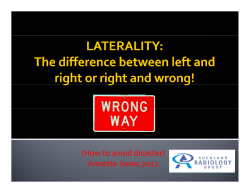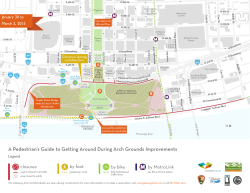
Total Body Adjustment for Children with Neurological Conditions
Total Body Adjustment for Children with Neurological Conditions Beyond the Treatment Table Jorge Aranda BSc (Hons) Ost Med MSc Ped Ost DO (UK) THE POLYGON OF FORCES Postural control is centered in the spinal column. Cranial, dorsal and sacral curves are primary embryonic curves. Lumbar and cervical curves are due to physical development and appear with the upright posture. All postural conditions of the posture center in the activity of the cervical and lumbar segments. During childhood spine development we are looking for the 4 arches to develop which provides the greatest amount of strength and elasticity with the least amount of shock transmission. Vulnerable areas to assess that carry the burden of the arch to arch formation and developments are: • D4 and corresponding ribs • D9 ad corresponding ribs • L3 1 Anteroposterior Line • Born in the occipital foramen • Crosses D11-D12 bodies. • Through the back of the joints L4-L5 and S1 body. • It ends at the top of the coccyx. • Determines the drive to spinal mechanics. 2 Line posteroanterior • It originates from the anterior margin of foramen magnum. • Through the anterior border of the L2-L3. • Eventually dividing into the acetabulum. • This line complements the anteroposterior line, both confluyen through the body of L3. • It is therefore the center of gravity of the spine. 3 The line of gravity • Born in the posterior third of the cranium • Passing through the dens • For the transverse C3, C4, C5 and C6 • Ahead of the D4; • Across the bodies of L1, L2, L3, L4 and sacral promontory. • It is divided in two through the hips, knees and ends at the talus-navicular joint. D4 represents the terminus of downward pressure and torsion of head movements and the point of greatest strain. Lesions at D4 will tend to destroy the correlation of the triangles to each other and is a critical point in terms of normal postural development or failure. D9 is a keystone / a stress point and a pivot. Three parts to play rolled into one. The strength of the arch between D5L2 will depend particularly on the inter-articulation above and below D9. If they fail to articulate properly the arch is considered weak not strong and you will find the entire arch between D5-L2 segmentally broken down into a series of short lateral curves. L3 is where the centre of gravity line passes through and this becomes the centre of gravity for the entire spine and body. It is a point of greatest strain because all the postural conditions of the body depend on this point either for a base or for support. It is the weakest point, because weight and tension antagonise each other here. OSTEOPATHIC CENTRES The Spinal Column is divided, for convenience sake, into six divisions: The Cervical, Brachial, Dorsal, Lumbar, Sacral and Coccygeal. OSTEOPATHIC CENTRES OSTEOPATHY bases its claim to rank as a science of healing upon the fact that there exists a definite and fixed relation between an organ and the central nervous system. This relation is secured through the segmented arrangement of the spinal nerves or through the sympathetic system, by means of rami communicantes. OSTEOPATHIC CENTRES The order of this innervation is fairly constant, though, as in the case with other portions of the body, it may vary. This variation in no wise invalidates the claim of Osteopathy to rank as a science, but it emphasizes the necessity of our searching for lesions even in regions relatively remote from the center. OSTEOPATHIC CENTRES Specific treatment in the sense of work exclusively upon a region said to be a center is rarely indicated. Owing to the diffusion of pain and its attendant conditions, it is necessary to remove any contracture which may be associated with it. Again, it sometimes occurs that disease of an organ produces no effect on its usual center, and in such an event it is necessary to carefully examine other regions for the trouble. OSTEOPATHIC CENTRES Know the location of the centers. Know also that occasionally a lesion causing the trouble must be found elsewhere. "Touching the button" is fascinating, both in theory and in practice, but the operator must be broad enough to expect it to be difficult occasionally to locate the button. The Cervical division C1-4 C1 is directly concerned with disturbances to the vasomotors of the eye and ear, and with diseases of the face. C2-3 is a general vasomotor center, through the superior cervical ganglion. It is a center for the side of the head, face, eye, nose, pharynx, tonsils and vessels of the brain. The Brachial division C4-D1 C3-5 is the center for hiccoughs, as it is the origin of the phrenics. C5-6 is the middle cervical ganglion and is the center for the thyroid gland. It also augments the heart action. C7-D1 control the heart, thyroid gland, inferior cervical ganglion, the vertebral and basilar arteries. The Dorsal division D1-12 D2-3 is the center for the ciliary muscle also the center for vomiting and for the bronchial tubes and bronchi. D2-5 are where the fibres augmenting the heart action. D2-6 are vaso-constrictors to the pulmonary blood vessels. D3-7 are vaso-motors to the arms, through the brachial plexus. D4 on the right is location for the stomach center. D6-10 is the origin of the great splanchnic where is the inhibitory, vasoconstrictor and secretary fibres are distributed to the stomach & small intestines. D8-10 on the right is the center for the liver. D9-10 on the left side is the center for the spleen is at the ninth and tenth dorsal on the left side. This is also the center for the uterus, through the hypogastric plexus. D11-12 is the center for small intestine, kidney and ovary control. The Lumbar division L1-5 L2 contains the center for parturition, micturition and the uterus. L2-4 is the center for diarrhea. L4-5 is where the pelvic plexus is formed by the separation of the hypogastric plexus into two halves on either side of the rectum. The fibres are distributed to the pelvic organs. The Sacral division S2-5 The anterior divisions of the sacral nerves are distributed to the rectum, bladder, sphincter ani, vagina and uterus. S2-3 center controls the bladder. S4 controls the vagina. S4-5 control the sphincter ani. 1900 - Littlejohn College of Osteopathy and Hospital in Chicago 1917 - British School of Osteopathy in London johnwernhamclassicalosteopathy.com John Wernham study Osteopathy at the invitation of J.M. Little john in 1928 In 1984 founded the Maidstone College of Osteopathy. The College was renamed The John Werham College of Classical Osteopathy in 1996. He passed away in 2007 at 99 years of age TOTAL BODY ADJUSTMENT They key to adjusting the body is by way of a process of integration. The Total Body Adjustment is the treatment that enables us to appeal to the lines of force i.e. The Polygon of Forces. The application of the treatment occurs through the body lines and triangles so the individual vertebrae and spinal arches function in relation to the polygon of forces. Asses and treat the pelvis as an integrated unit: • Two hips joints • Coccyx • Two SI joints • L5 This is the baseline of the polygon. In the biomechanics of the spine is important to understand the natural curves that has the spine, which function to cushion and distribute the axial pressure on the disc and bodies, and determine the static and balance. Throughout the developmental milestone of a child we look far any segmentation of vertebral groups or arch to arch breakdown. Bearing in mind that a child aged between 0-7 years is erecting its centre of gravity line and the mechanism that provide balance structurally and functionally in relation to this line. The structural and functional stability of D4 to the occiput and L3 to the pelvis depends on the mechanical form and function of the central arch D5-L2. Asses and treat the central arch D5-L2 this is a double arch with a balance of alternate tension and compression forces and the strength of this region. Asses and treat the condition and position of L3 bearing in mind that is the centre of gravity and point of maximum strain. From 7-14 years if the balance mechanism is not secure and struggling to develop and mature, compensatory mechanism take over, so at puberty and beyond the body begins to harden with all its lesion patterns and irregularities. Frequency of treatment will vary from child to child depending on the acute nature, chronicity and severity of the child´s condition. John Wernham used to advocate for the chronic case, approximately a year of treatment for every 10 years of life. The lumbar curvature is determined by static lines of force. Asses all parameters of the range of movement of the spinal column including the side bending component The lateroflexion at the level of the dorso-lumbar region can be restricted due to the obligatory muscles of respiration Quadratus Lumborum and the hip flexors Ilio-psoas Dysfunction of the 12th Rib can limit the mobility of the ilium and interfere the distribution of forces from the lower limbs to the upper extremities through the thoracolumbar fascia. Lower ribs mechanics express the respiratory function of the diaphragm and the cavity dynamics of the corresponding visceral column. Viscero spasm can interfere with upper pelvis and lumbar mechanics through the visceral fascia attaching to the posterior abdominal wall. Told´s fascia provides support to the ascending and descending colon having a profound influence in the mobility of the sigmoid colon and the range of movement of the left sacro-iliac joint. From a mechanical point of view L3 is a key vertebra for the interconnection between the abdominal cavity through the 2nd portion of the duodenum, the lower ribs through the diaphragm and the lower extremities through the posts The distribution of forces from the pelvis to the spinal column occurs by the connective tissue of the ilio-lumbar ligaments which connect the fourth and fifth lumbar vertebrae with the ilium. The superior triangle converges at the level of D4 and therefore addressing the cranial structures need to be done before aiming to restore normal function of that segment. Normal rib function cannot be restored before adjusting the normal mechanics of the dorsal vertebrae. Reverse curvature of the dorsal segments are usually due to anterior restrictions from the internal structures of the thoracic cavity through the vertebro-pericardic ligaments and the central tendon. Lateral expansion of the lower ribs might be limited due to visceral congestion of the liver or the spleen. Vasocongestion to these organs must be address through the related dorsal segments. Liver pump and lymphatic pumping techniques are crucial to maintain propper physiological levels of blood and lymph through the body structures to achieve normal levels of pH. Oscillatory axis of rotation must be remembered when adjusting lumbar segments once the soft tissues has been normalized. BIBLIOGRAPHY 1. Campbell C., A Review of Spinal Mechanics, IPR 1996 2. J. M. Littlejohn., Chart of the Osteopathic Centres & of the Somatic & Autonomic Nervous System, The Maidstone College of Osteopathy 3. J. M. Littlejohn., The Mechanics of the Spine, Lecture Notes 4. J. Wernham., Mechanics of the Spine, I.A.O. Year Book 1985 THANK YOU FOR YOUR ATTENTION jorgeosteo@gmail.com Total Body Adjustment for Children with Neurological Conditions Beyond the Treatment Table Jorge Aranda BSc (Hons) Ost Med MSc Ped Ost DO (UK)
© Copyright 2025











